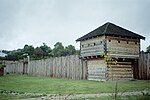Tu-Endie-Wei State Park

Tu-Endie-Wei State Park is located at the confluence of the Kanawha River and the Ohio River in downtown Point Pleasant, West Virginia. The park commemorates the Battle of Point Pleasant, fought between the settler militia of Virginia and the forces of Shawnee Chief Cornstalk on October 10, 1774. The militia victory by the settlers weakened the alliance between native forces and the British and freed up settlers from western Virginia to cross the Allegheny Mountains and join in the American Revolutionary War. The name "Tu-Endie-Wei" refers to the Wyandot Indian phrase meaning "the point between two waters" in English.The Battle of Point Pleasant has been recognized as the first battle of the American Revolutionary War by the National Society of Daughters of the American Revolution. Female descendants of battle veterans are allowed to join the D.A.R. The historical debate about the first battle claim may not yet be resolved.The 1796 Mansion House is historic house museum originally used as a tavern. The Colonel Charles Lewis Chapter, N.S. Daughters of the American Revolution operates the Mansion House Museum on a seasonal basis.
Excerpt from the Wikipedia article Tu-Endie-Wei State Park (License: CC BY-SA 3.0, Authors, Images).Tu-Endie-Wei State Park
1st Street,
Geographical coordinates (GPS) Address Nearby Places Show on map
Geographical coordinates (GPS)
| Latitude | Longitude |
|---|---|
| N 38.839166666667 ° | E -82.140833333333 ° |
Address
Battle of Point Pleasant Monument
1st Street
25550
West Virginia, United States
Open on Google Maps







